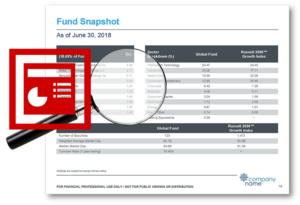Financial Brands Need a Cross-Organizational Social Strategy
It’s good policy for social media marketers to have a relationship with every level of their organization, but it’s even more imperative for in the financial services industry.
In any regulated industry, marketing teams should focus on working closely with compliance and legal departments to make sure outgoing communications stay within the rules. Social media provides an excellent way for asset managers to advertise and build trust with customers, but it also creates fertile ground for marketing blunders and compliance errors.
Nevertheless, as communications with financial services firms continue to go social, it’s more necessary than ever that these organizations have proper social media strategy in place. In fact, a social media plan is beneficial for the entire company, not just the marketing department.
Why do financial brands need a social strategy?
A new generation of investors is going online and are frequently using social media to gain insights into investing decisions. However, it’s not just millennials taking over the social sphere, investors are increasingly utilizing Twitter and other platforms to make informed decisions about their assets.
According to 2012 data from the Brunswick Group, 28 percent of investors looked into an issue more deeply based on information found on Twitter, and 12 percent of investors had made an investment decision after viewing content on Twitter.
The study also found that investors are providing their own information on social platforms. This means that it’s important for asset managers to not only provide useful information on social media, but also engage with the investors who are already using the platform. The problem is, many financial services firms don’t have a social media strategy.
For one thing, a social strategy can prevent large scale mistakes like the ones that rise to prominence in the media, for instance, Chase Bank’s #AskJPM project, which invited users to tweet to the bank’s executives using the outlined hashtag. As Bloomberg pointed out, Twitter users instead utilized the hashtag to hurl snarky and critical comments at the bank. McDonalds experienced something similar with its #McDStories hashtag campaign.
Involving the entire team in marketing initiatives like this can help asset managers consider every possible angle to prevent these kinds of disasters from ever taking place. On the other hand, in highly regulated industries, more can be at stake than just the reputation of a business.
In addition, regulations are always in flux, and asset management firms need to keep up. For instance, in the U.K., the Financial Conduct Authority recently announced that firms need to maintain a “media-neutral approach” to ensure that customers are presented with necessary information, Marketing Week reported. While the organization does not want to dissuade companies from using channels that can be valuable to them, it also wants to maintain transparency with consumers. The U.S. isn’t immune to such changes either. In all markets, regulations are subject to change, and both compliance teams and marketing and sales departments need to be on top of these nuances as they come up.
How Citi Bank got everyone involved in their social strategy
The LinkedIn blog reported on FinanceConnect:13, and highlighted Citi Bank’s approach to social media. Linda Descano, Managing Director, Head of Digital Partnerships, Content and Social at Citi, said that social marketers need to cultivate close relationships with legal and compliance. To accomplish this at Citi, Descano created social media forums where marketing and compliance get together and brainstorm.
For Citi, this allows new ideas to move forward more quickly. This strategy ensures that every plan that comes out of the sessions is already compliant and ready to go. It also reduces the back-and-forth that can take place between these departments, allowing marketers to hit the ground running. Every organization will have a different approach that will work best, but the important thing is getting the entire organization on the same page when it comes to social media use. This isn’t an initiative to be taken lightly. Instituting a thorough and compliant social media policy could take a lot of planning and legwork.
How to get started with a social strategy
A white paper from Hootsuite reiterated the idea that social media compliance should be a company-wide concern, not just the purview of marketing departments. In fact, social media strategy should reach far higher, even up to the board of directors. At the C-suite level, executives need to determine how social media use aligns with overall business goals. Compliance and legal departments should be included in these initial meetings to determine what ideas will be possible and how they can be carried out. Whether asset managers take Citi’s approach or a different one, having all hands on deck during an initiative like this can ensure eventual success.
As Hootsuite recommends, ownership of social media platforms should be centralized, not siloed in the marketing department. This also means that companies will need to create a formal and thorough social media use policy. Since this is a company-wide project, you should get input from a number of different departments, including compliance, legal, information technology, human resources, marketing and any staff members who are particularly experienced in social media.
Once created, asset management firms will need to make sure the policy is in line with similar policies for blogs, email and other channels. For instance, what types of social media communications does Financial Industry Regulatory Authority consider to be advertisements? What about sales literature or correspondence? Additionally, specific workflows should be established for approving social media posts.
After you’ve come up with a policy and made sure that it’s in line with similar marketing and promotions policies, you need to make sure you thoroughly educate everyone in the company. Especially because most employees are likely using social media already, they need to understand the difference between personal use and compliant use of social media.
In the end, using social media is a smart choice for asset management firms. But these groups need to make sure their social media compliance policies are understood and utilized by the whole firm, not just the marketing department.








 Compare the Top 3 Finserv Content Automation Vendors [White paper]
Compare the Top 3 Finserv Content Automation Vendors [White paper] Create Pitchbooks the Drive Sales [White paper]
Create Pitchbooks the Drive Sales [White paper] Build vs. Buy: Should Your Financial Services Firm Outsource or Insource Marketing Technology? [White paper]
Build vs. Buy: Should Your Financial Services Firm Outsource or Insource Marketing Technology? [White paper]  10 Tips for Rebranding your Fund Marketing Documents [White paper]
10 Tips for Rebranding your Fund Marketing Documents [White paper]

